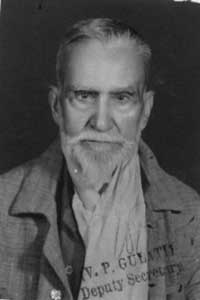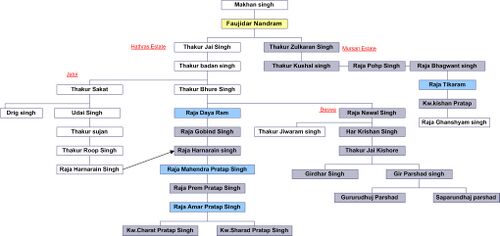Thenua


Thenua (ठेनुवा)[1] Thenuva (ठेनुवा) Thainua (ठैनुवा) Thenewal (ठेनेवाल)[2] Thinwa (ठीनवा)Thinwan (ठीनवां)[3] Thinwal (ठीनवाल)[4] [5] Thenwa (ठेनवा) is a gotra of Jats found in Uttar Pradesh and Rajasthan. They write Tenpa/Tanya for Thenba Jat in Afghanistan. [6] It is a Baloch Jat clan found in Afghanistan.[7] They were supporters of Tomar Confederacy. [8]
Origin
This gotra originated from Chandravanshi Jat. They are said to have 'decided to oppose' (ठानना) the Mughal Badshah hence called Thenua. [9]
History
Thenua Jats were the rulers of Mursan state, Hathras state, Beswan state, Vrindawan state and Baldevgarh state, all in Uttar Pradesh (Thenua Jats Royal Families).
At the end of 16th century Thenuas came from Rajasthan to Brij under the leadership of Makhan Singh. They settled near Javra and occupied nearby areas. This was during the reign of Mughal ruler Jahangir. Their state was officially known as Tappa Javra.[10]
Makhan Singh - Makhan Singh married with daughter of Khokhan gotra Jats, who were in occupation of areas around Raya. After marriage Makhan Singh organized Jats of that area and gathered power. He constructed forts at Gausna (गौसना), Sindura (सिन्दूरा) etc. which were visited by historian Thakur Deshraj.[11] [12]
During the end of reign of Shahjahan, Sadulla Khan made a cantonment to control the growing power of Jats at place known as Sadabad. In 1652 AD Sadulla Khan occupied [Tappa]] - Javra of Jats, part of Jalesar, some villages of Khandoli, 80 villages of Mahavan and merged them with Sadabad pargana. This way Jats came under Mugals but they did not pay any Tax. [13]
Nand Ram (r. 1645 -1695) - After Shahjahan, Makhan Singh's grandson Nand Ram again organized the Jat power and became strong by merging Porcha Raja of Dariyapur with him. When Aurangzeb became the ruler of Delhi he could not ignore Nand Ram and awarded him the title of Faujdar and handed over Tochhigarh tahsil to him. Nand Ram ruled tactfully and bravely for 40 years and died in 1695. [14]
Nandram had 14 sons out of them Jalkaran was eldest. Second son was Jai Singh, seventh son was Bhoj Sing, 8th son was Churaman, 9th son was Jaswant Singh, 10th Adhikaran, 11th Vijay Singh. Churaman ruled Tochhigarh. Jaswant Singh ruled Bahramgarhi. Jalkaran died before Nandram. His able son Kushal Singh became successor.
Thakur Kushal Singh - Kushal Singh got villages Rahatpur and Makrol from his uncle Bhoj Singh. Kushal Singh won Dayalpur, Mursan, Gopi, Putaini, Ahri, and Baramai areas from Sa'adat Ullakhan. The famous fort of Mursan was constructed by Kushal Singh. He had enhanced his power over large areas like Mathura, Hathras and Aligarh. [15]
Puhap Singh - After Kushal Singh his son Puhap Singh became the ruler. Puhap Singh lost war with Bharatpur. He had to leave Mursan and went to Sasni and occupied it. He constructed a strong fort here. Sasni is known as a a fort of Jat pride. In 1761 he accepted rule of Maharaja Jawahar Singh of Bharatpur and given back Mursan in friendship. Puhap Singh did great help to Jawahar Singh in Delhi war. As a result it annoyed the Delhi rulers. Delhi ruler Najib Khan sent his army to attack Mursan. Jats fought bravely but had to leave Mursan. Puhap Singh struggled for 10 years to get back Mursan. He succeeded in 1785 to get back Mursan. He continued to expand till his death in 1798. [16]
As said earlier out of 14 sons of Nandram, two were more famous: Jalkaran Singh and Jai Singh. Jalkaran's grandson was Raja Bhagwant Singh, who was ruler of Sasni and Mursan. Jai Singh's grandson was Daya Ram, who became ruler of Hathras. Bhagwant Singh later helped Lord Lake and got Sonkh and Madan in Jagir. According to Mathura Memoirs, the rulers of Mursan and Hathras considered them selves Independent. In 1817 Mursan and hathras forts fell to British under General Marshal. Raja Daya Ram thought it appropriate to have a treaty with British rule. [17]
Raja Daya Ram ( 1775-1841) - After the death of Thakur Bhuri Singh 1n 1775,his son Daya Ram ascended the throne of Hathras. He was a astute ruler and was well versed in the literary circles. He was the first to assume the title of Raja of Hathras. Historians credit him to have brought the all round progress and prosperity of Hathras as a state. He expanded territories Hathras which in his time included Simardhari, Tochhigarh, Gubrari, Barhad, Karas, Karil, Mant, Mahaban, Hasangarh, Sahapau and Khandoli towards Agra. He was considered along with Raja of Mursan Raja Bhagwant Singh were considered the most powerful chiefs in this part of the country by the Britishers. Hathras was said to be the strongest fort in the country.
Thakur Gobind Singh (1841-1861) - On his father's death held only a portion of one village, Shahgarh, and merely a Motgagee, succeeded Raja Dayaram. Britishers had reduced the Hathras estate to minimum during the reign of Raja Daya Ram. Thakur Gobind Singh with his no conflict views and his loyal services to the Britishers during the 1857 mutiny ,was able to get much of Hathras estate back which also included the Mathura villages and the Koil estate of Aligarh.
Raja Harnarain Singh (1861-1896) - When the upheaval of 1857 was over, Raja Govind Singh died in 1861. He was survived by his wife Rani Sahib Kunwar of Bharatpur and an infant son, but the son died due to illness months after his father. The Raja had authorised to adopt a son. She selected Har Narain singh,the son of Thakur Rup singh Of Jatoi, a descendent. He resided with Rani sahib in Vrindavan at Keshighat presently PMV. He married Rani Swarup Kaur from Bharatpur and the second one was from Dholpur, Rani Hanumannt Kaur. He could not have any successor born out of his two ranis, hence he adopted Kunwar Kharag Singh from Mursan, who later came to be known as Raja Mahendra Pratap Singh.
Raja Mahendra Pratap Singh (1886-1979) -
Raja Prem Pratap Singh (1913-1947): He was just one year old when his father left the family for the quest of freedom of India.He became the estate owner in 1924 as according to the act when he was just 11 years old. His mother passed away in 1925 when he was just 12. Hence he only had his elder sister Bhakti Devi whom he loved dearly.In 1931 when he turned 18 he became the legal owner of the estate.This is the time when he gave much of the estate on lease. The estate was also able to win some important cases under him. He married an English lady named Georgiana who unfortunately left back to England in 1946. Her going back had justification. They had two children Amar Pratap and Sarla Devi. After his wife left Prem Pratap Singh became a lonely man. He mysteriously passed away on 13th June 1947 in Vrindavan. He was just 34 years old.
Raja Amar Pratap Singh -Born in Dehradun on 4th Jan,1940. - He was just 6 years old when his mother left and went back to England. His father passed away in 1947 when he was only 7 years old. He had a similar situation as his father. After 1947 as according to the act he became the owner of the estate. He was offered to join politics by various parties, late Indira Gandhiji personally wrote to him to join the party but he stayed away from politics. He married to Balbir Kaur in 1968 in Dehradun and now he has three children Meeta, Charat and Sharad. He knew the importance of family,hence he devoted his attention to them and stayed away from the estate affairs as much as could. He inherited qualities from his grandfather as he too never had any interests and hunger for power.He now lives comfortably with his family in Dehradun Villa.
The most well known ruler of this state was the Jat nobleman, Raja Mahendra Pratap (1886-1979), who was popularly known as Aryan Peshwa. The third son of Raja Ghansyam Singh, he was adopted by Raja Harnarayan Singh of Hathras.
Mahendra Pratap married a lady from a Sikh family based in the princely state of Jind in present-day Haryana.
Villages founded by Thenua clan
- Nagla Tejsingh - Village was founded by Thakur Sampat Singh in name of Tej Singh Thenua, his brother.
Genealogy of Mursan and Hathras rulers

Genealogy of Mursan rulers:
Makhan Singh → Nand Ram (r. 1645 -1695) → Jalkaran Singh → Kushal Singh → Puhap Singh → Bhagwant Singh → Tika Ram → Kunwar Kisan Pratap → Ghan Shyam Singh
Genealogy of Hathras rulers:
Makhan Singh → Nand Ram (r. 1645-1695) → Jai Singh → Badan Singh → Bhure Singh → Raja Daya Ram ( 1775-1841) → Thakrur Gobind Singh (1841-1861) → Raja Harnarain Singh (1861-1896) → Raja Mahendra Pratap Singh (1886-1979) → Raja Prem Pratap Singh (1913-1947) → Raja Amar Pratap Singh (b.1940)
Genealogy of Jatoi rulers:
Makhan Singh → Nand Ram (r. 1645-1695) → Jai Singh → Thakur Badan Singh Thenua → Thakur Sakat → Udai Singh → Thakur Sujan → Thakur Roop Singh → Raja Harnarain Singh (1861-1896)
Genealogy of Beswa rulers:
Makhan Singh → Nand Ram (r. 1645-1695) → Jai Singh → Thakur Badan Singh Thenua → Bhure Singh → Raja Nawal Singh → Har Kisan Singh → Jai Koshore → Gir Prasad Singh
Thenua Khap
Thenua khap has 150 villages in Uttar Pradesh in Aligarh and Mathura districts. Jat gotra is Thenua. Two jat states Mursan and Hathras were from this khap. Raja Mahendra Pratap was world known personalities of this khap. Nandram Jat a brave son of the soil who fought tooth and nail with Aurangzeb was also from this khap. Mursan and Hathras states were of this Khap.[18]
ठेनुआ खाप
27. ठेनुआ खाप - करीब 150 गांव की यह खाप मथुरा और अलीगढ़ दोनों जनपदों में फैली हुई है. इस खाप के राजा महेंद्र प्रताप विश्व प्रसिद्ध व्यक्ति हुए हैं, जिन्होंने स्वतंत्र भारत की पहली निर्वाचित सरकार बनाई थी. जिस नंदराम जाट ने औरंगजेब को नाकों चने चबाये. वह भी इसी खाप का वीर सपूत हुआ है. मुरसान और हाथरस दो राजघराने भी इसी हाथ में पड़ते हैं. [19]
Distribution in Uttar Pradesh
Thenua Khap has 150 villages in Mathura district. [20]
Villages in Hathras district
Baghena, Chirawali, Chitawar Hathras, Khaunda, Khutipuri, Mai Hathras, Mursan, Nagla Sikurra, Nangla Ani, Naupura, Pharsauti, Sadabad, Saroth, Senpur, Surtiya, Tajpur, Udaybhan,
Villages in Aligarh district
Bas Harji, Baraula, Barhsera, Byonhara, Gadua, Gorai, Gwalra, Kaimawali, Kajroth, Karil Hathras, Mohakampur, Muhraini, Nagla Badhiya (Harautha), Nagla Jagta, Shaharimadan Gari, Shyam Garhi, Simardhari, Tappal[21] Tehara, Udambara,
Villages in Bulandshahr district
Baghrai, Hajaratpur Poothri, Nagal,
Villages in Mathura district
Byonhi, Ekhu, Gonga Mathura, Shankar Garhi, Tirwaya,
Distribution in Rajasthan
Villages in Jaipur district
Villages in Bharatpur district
Distribution in Madhya Pradesh
Villages in Ratlam district
Villages in Ratlam district with population of this gotra are: Thenua: Ratlam 2,
Villages in Morena district
Villages in Hoshangabad district
Villages in Khargone district
Villages in Gwalior district
Birlanagar (Gwalior), Gwalior,
Villages in Indore district
Villages in Shivpuri district
Villages in Bhopal district
Villages in Vidisha district
Gopalpur Vidisha[22], Raikhedi vidisha
Villages in Shajapur district
Villages in Raisen district
Distribution in Delhi
Notable persons from this gotra
- Raja Mahendra Pratap - The most renowned person of Thenua gotra.
- Late Kunwar Narendra Singh Thenua - Village Byonhi, Nagla Birbal, Uttar Pradesh
- Dr N.P.Singh Verma
- Mukesh Kumar (Thenua) - Home district Churu, DGM BSNL , Date of Birth : 2-January-1976, Present Address : V/42, TELECOM COLONY, BAJAJ NAGAR, JAIPUR, RAJASTHAN, Resident Phone Number : 0141-2702126, Mobile Number : 9413394072,
- Vineet Kumar Thenua - Sub Inspector in UP Police. He belongs to Udambra , Iglas (Aligarh).
References
- ↑ Jat History Dalip Singh Ahlawat/Parishisht-I, s.n. ठ-7
- ↑ Jat History Dalip Singh Ahlawat/Parishisht-I, s.n. ठ-6
- ↑ O.S.Tugania:Jat Samuday ke Pramukh Adhar Bindu,p.41,s.n. 988
- ↑ Jat History Dalip Singh Ahlawat/Parishisht-I, s.n. ठ-8
- ↑ O.S.Tugania:Jat Samuday ke Pramukh Adhar Bindu,p.41,s.n. 988
- ↑ An Inquiry Into the Ethnography of Afghanistan, H. W. Bellew, p.102
- ↑ An Inquiry Into the Ethnography of Afghanistan, H. W. Bellew, p.186
- ↑ Jat History Dalip Singh Ahlawat/Chapter III,p.192
- ↑ Mahendra Singh Arya et al: Adhunik Jat Itihas, p. 249
- ↑ Thakur Deshraj:Jat Itihas, p. 563
- ↑ Thakur Deshraj:Jat Itihas, p. 563
- ↑ Mahendra Singh Arya et al: Adhunik Jat Itihas,
- ↑ Thakur Deshraj:Jat Itihas, p. 563
- ↑ Thakur Deshraj:Jat Itihas, p. 564
- ↑ Thakur Deshraj:Jat Itihas, p. 564
- ↑ Thakur Deshraj:Jat Itihas, p. 564-65
- ↑ Thakur Deshraj: Jat Itihas, p. 567-68
- ↑ Dr Ompal Singh Tugania, Jat Samuday ke Pramukh Adhar Bindu, p. 16-17
- ↑ Dr Ompal Singh Tugania, Jat Samuday ke Pramukh Adhar Bindu, p. 16-17
- ↑ Jat Bandhu, Agra, April 1991
- ↑ Jat History Dalip Singh Ahlawat/Chapter VIII (Page 623)
- ↑ User:Sk56
- ↑ User:Veerlohan
Back to Gotras
- Jat Gotras
- Gotras after Persons
- Gotras after Titles
- Uttar Pradesh
- Rajasthan
- Delhi
- Gotras in Hathras
- Gotras in Aligarh
- Gotras in Bulandshahr
- Gotras in Mathura
- Gotras in Jaipur
- Madhya Pradesh
- Gotras in Ratlam
- Gotras in Morena
- Gotras in Gwalior
- Gotras in Indore
- Gotras in Shivpuri
- Gotras in Bhopal
- Gotras in Raisen
- Gotras in Hoshangabad
- Jat Gotras in Afghanistan
- No Origin
- Genealogy
- Bard History
- Tomar History
- Jat History

